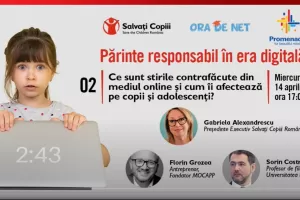Nearly a third of children believe that fake news cannot be presented on TV or on news sites. Half of the children rarely or never check the truth of the information found online. In the context of children spending (in Covid-19 pandemic) many hours on the Internet, the risk of finding fake but very credible materials initially, such as: humanitarian campaigns for people who do not actually exist, online orders form people who are not to be found the next day, extraordinary competitions that ask for your personal data for generous extractions, rumors against the background of the global pandemic crisis or others as such have increased.
The following topics were addressed: What is false information in the online environment and in what form can it be found by children? How fake online content affects children and teens? or Developing critical thinking in children and adolescents.
About this resource
Nearly a third of children believe that fake news cannot be presented on TV or on news sites. Half of the children rarely or never check the truth of the information found online. In the context of children spending (in Covid-19 pandemic) many hours on the Internet, the risk of finding fake but very credible materials initially, such as: humanitarian campaigns for people who do not actually exist, online orders form people who are not to be found the next day, extraordinary competitions that ask for your personal data for generous extractions, rumors against the background of the global pandemic crisis or others as such have increased.
The following topics were addressed: What is false information in the online environment and in what form can it be found by children? How fake online content affects children and teens? or Developing critical thinking in children and adolescents.
About this resource
- clickbait commercialism copyright disinformation misinformation
Related content
- < Previous resource
- Next resource >
- < Previous
- Next >






